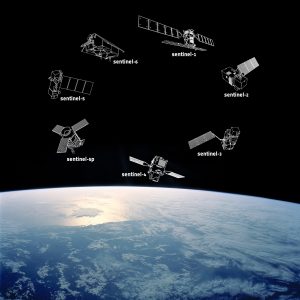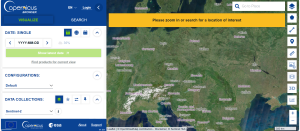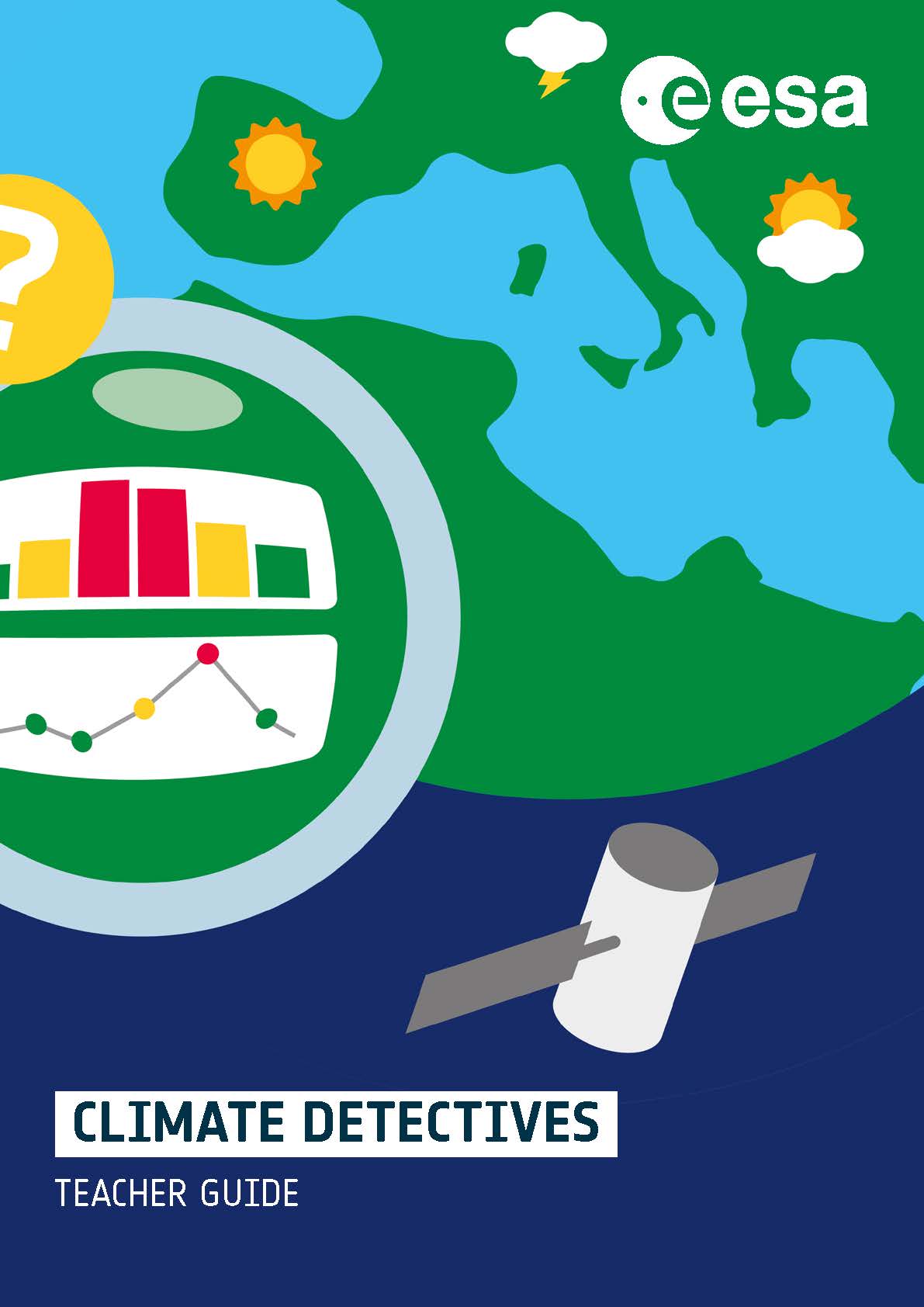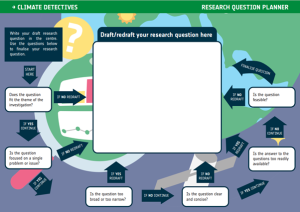

About Climate Detectives
Climate Detectives challenges students to make a difference in researching and protecting Earth!
In this project students will embrace the role of Climate Detectives while learning about Earth’s environment and climate.
The project is structured in three steps:
-
Phase 1 - Teams identify an Earth's environment or climate problem
-
Phase 2 - Teams investigate the problem by using real satellite images or their own ground measurements
-
Phase 3 - Teams propose actions to "make a difference" and share their results
For the beginners level refer to Climate Detectives Kids.

Up to 8 months
From 8 to up to 18 years old
2 students up to the whole class
Award (*)
(*) teams selected by the National Organisers will be invited for the Climate Detectives Summit at ESRIN in Italy 12th-13th of May 2025.
Up to 8 months
From 8 to up to 19 years old
2 students up to the whole class
Competitive (*)
(*) teams selected by the National Organisers will be invited for a learning and celebration event at an ESA site.
Start your investigation
Climate Detectives is run by the European Space Agency (ESA) and the national European Space Education Resource Offices (ESEROs) throughout Europe.
For more information about the timeline and the registration process visit your country page.
Why participate
By participating in the Climate Detectives project, students will understand Earth’s environment as a complex and changing system as well as learn the importance of respecting our environment.
Students will have the opportunity to learn from scientists and Earth Observation experts through videos, webinars and other opportunities organised at national level.
Who can participate
- Age range: participation is open to teams of students up to 18 years old.
- Teams: must be comprised of a minimum of two students up to the whole class.
- Each team must be supervised by a teacher or mentor acting as the team’s point of contact with ESA’s Education Office and, where applicable, with the respective National Organiser.
- At least 50% of the team members must have the nationality of an ESA Member State. Further to the 22 Member States, also Canada, Latvia, Lithuania, Slovakia and Slovenia, based on their agreements with ESA, qualify to fully participate in the programmes of the ESA Education Office.
Become a Climate Detective
The Climate Detectives school project is divided into three phases throughout the school year:
Team up and read carefully the guidelines of the project.
Identify your research question and the data to be investigated.
Register your team and share your investigation plan details (*)
Investigate your problem and collect data.
Organise and manage data.
Analyse data and draw conclusions.
Decide on any actions to be taken.
Showcase the project.
Submit and share your project and conclusions at climatedetectives.esa.int.
Teams selected by the National Organisers will be invited for a Climate Detectives Summit at ESRIN, Italy on 12th-13th of May 2025. Learn more here.
(*) The investigation plan will serve as a guide for the next steps of the teams’ investigation. National organisers, with the help of EO scientists and experts, may provide feedback and recommendations about the investigation plan submitted.
Climate Detectives is a project-based activity designed to be completed in 8 months but can be adapted. Timeline and submission moments may differ according to the National Organiser. Check here if there is a National Organiser in your country.

Background information
The Climate Detectives teacher guide provides a set of steps and approaches that teachers might employ with students to ensure that participating in the Climate Detectives project replicates the scientific method. The Teacher’s Guide is divided into three phases corresponding to the different phases of the project:
- Phase 1: Identify a an environmental or climate problem
- Phase 2: Investigate the problem
- Phase 3: Share results and make a difference
Download the teacher guide in PDF format in English or consult more information about the different phases below.
Phase 1 - Identify an environmental or climate problem
In phase 1, the focus is on engaging students to think about and discuss Earth’s environment and climate and guiding them towards identifying a local environmental problem that they would like to investigate as ‘Climate Detectives’. Planning is an important step in any investigation.
The 4 to steps involved in phase 1 are:
1. Engage the students
Though not an absolute necessity for the project, establishing a base line of student knowledge on the topic is recognised as a best practice. When students are engaged and their interest and curiosity stimulated, they are more likely to actively participate in becoming a Climate Detective.
During the course of the project students will have the opportunity to increase and consolidate their understanding of key topics and concepts related to the environment, climate and climate change. At the outset, teachers can ensure they have a basic knowledge of key words, terminology and concepts, thus giving them the necessary tools and language to embark on the project.
Here are some examples of how students can be engaged and their prior knowledge activated:
- Questioning: Ask the students what they know about our environment and climate? Do they know the difference between weather and climate? Have they heard of the causes and effects of climate change on the environment?
- Videos: Have students watch short documentaries or videos on the topic.
- Web research: Have students conduct web research to explore key words and terminologies (see below for examples).
- Mind Map: Have students produce a mind map illustrating what they know about Earth’s environment and climate, either as a class, group, or individual activity.
Introduce key words, terms, and concepts
There are several key words and phrases which students will need to understand and use in this project. These include:
- Climate
- Climate change
- Weather
- Weather events
- Fossil fuels
- Greenhouse gases
- Greenhouse effect
- Global warming
- Environmental pollution
As key words and phrases arise, it is a good idea to note them on a whiteboard or flipchart so that students are reminded of them for later. Use some of the inspirational Classroom Resources for Climate Detectives available in the Resource Section.
Here are some suggested classroom activities that will help to enhance student understanding of key terminology and concepts.
Suggested primary classroom activities
 Nose up high in the sky: This activity is designed for primary pupils to learn how their senses can be used to describe weather conditions. Pupils build a small meteorological station and take weather measurements and learn that scientists need to have access to reliable instruments to make precise weather forecasting.
Nose up high in the sky: This activity is designed for primary pupils to learn how their senses can be used to describe weather conditions. Pupils build a small meteorological station and take weather measurements and learn that scientists need to have access to reliable instruments to make precise weather forecasting.
Access resource here.
 The ice is melting: This set of four activities allows primary pupils to explore the impact that global warming and melting ice could have on sea levels. Pupils learn the difference between land ice and sea ice and consider why ice on Earth is melting. They investigate the respective effects of the melting of land ice and sea ice.
The ice is melting: This set of four activities allows primary pupils to explore the impact that global warming and melting ice could have on sea levels. Pupils learn the difference between land ice and sea ice and consider why ice on Earth is melting. They investigate the respective effects of the melting of land ice and sea ice.
Access resource here.
 Earth under the lid: Primary pupils investigate what the greenhouse effect is and analyse a video to discuss the consequences of an increasing amount of greenhouse gases.
Earth under the lid: Primary pupils investigate what the greenhouse effect is and analyse a video to discuss the consequences of an increasing amount of greenhouse gases.
Access resource here.
Suggested secondary classroom activities
 The greenhouse effect and its consequences: This set of activities includes hands on experiments and the interpretation of satellite images to better understand of the effects of global warming.
The greenhouse effect and its consequences: This set of activities includes hands on experiments and the interpretation of satellite images to better understand of the effects of global warming.
Access resource here.
 Sea ice from space: Students investigate Artic sea ice. They will learn where in the world it is possible to find sea ice and analyse up to date and long-term data about sea ice concentration.
Sea ice from space: Students investigate Artic sea ice. They will learn where in the world it is possible to find sea ice and analyse up to date and long-term data about sea ice concentration.
Access resource here.

Highways of the oceans: Students learn about sea currents, the highways of the oceans and how important they are in understanding local climates.
Access resource here.
Explore the Climate Detectives Mini Case Studies to different topics to get an idea of what your project could look like. You will find examples of activities based on real world situations.
2. Identify the research question
The students are now ready to formulate a research question. To help them focus on a topic they would like to research they could:
- Visit the project gallery to research previous Climate Detectives entries.
- Research local media and search for articles exposing local environmental and climate problems in their communities.
- Check for any reports on recent environmental changes, incidents which polluted the environment or climate events that could help identify suitable questions.
- Contact local environmental authorities to ask if they have concerns about the local environment and climate issues including flooding, storms or changes in biodiversity.
- Identify geographical features and habitats suitable for investigation in their locality e.g. school grounds, parks, woodland, rivers, mountain ranges, sandy beaches, etc.
What makes a good research question?
Brainstorm ideas in the classroom. Ideas and questions can be displayed and shared on an ideas wall. The students can then discuss the various ideas. Students can be guided to formulate a good research question using the following criteria:
- Does the question fit the theme of the investigation?
- Is the question focused on a single problem or issue?
- Is the question too broad or too narrow?
- Is the question clear and concise?
- Is the answer to the question too readily available?
- Is the question feasible (consider timeframe, access to resources, student capability)?
Students can print out the research question planner to draft their research question. This will help them select and agree on the best research question for the project while keeping in mind what constitutes a good research question.
3. Identify the Earth observation data to be investigated
Once the research question is decided, students must plan what Earth observation data they need to collect and what field / laboratory studies they require to answer the question.
Students can be encouraged to check out what teams have investigated and what data they collected / analysed in the past editions by visiting the project gallery.
Types of Earth observation data
Earth observation (EO) is the collection, analysis and presentation of data to better understand our planet. Earth observations can be taken at a local ground level or acquired from remote sensing platforms such as satellites. As satellites continuously acquire images of our planet from orbit, they have become powerful scientific tools to enable better understanding of the Earth and its environment. From above, satellites can collect data from sites all around the world, including places too remote to visit in person.
Earth observations may include:
- measurements taken by a thermometer, wind gauge, ocean buoy, altimeter or seismometer;
- photographs taken on the ground or from airplanes;
- radar or sonar images from land-based or ocean-based instruments;
- a birdwatcher’s notes on bird sightings;
- images taken from remote-sensing satellites;
- measuring land use change;
- tracking biodiversity and wildlife trends;
- processed information such as maps or weather forecasts;
- monitoring and responding to natural disasters such as fires and floods.
How might local ground data be collected?

- Observations
- Measurements
- Counting
- Surveys
- Laboratory experiments
- Field experiments
How might satellite data be accessed?
The European Space Agency (ESA) is developing a new family of satellites called Sentinels for the European Union’s Copernicus programme. Each Sentinel satellite carries state-of-the-art instruments that generate imagery and data open to users worldwide, giving everyone the opportunity to become an Earth observer.
Copernicus Browser
Copernicus Browser is an online platform that combines an archive of Copernicus Earth observation missions and can be used to find satellite images in high-resolution of any area of interest. Data is freely available. Copernicus Browser gives the option to access specific satellite data tailored to a selected theme. Themes cover different topics, from agriculture to atmosphere and water bodies.

Students should have a clear idea of the satellite data/mission they wish to explore to help them with their research. Check the EO Data section for more information.
Data quality
Good data should be:
- Accurate (instruments read correctly)
- Reliable and valid (can be trusted)
- Complete (no missing data / no gaps in the data)
- Relevant (will the data help to answer the research question?)
- Comprehensive (students may be interested in recording one data variable e.g. temperature BUT it may be useful to include other variables such as wind speed, humidity and cloud cover as these might be useful in analysing temperature trends.
Determine how the problem will be investigated and which data will be analysed
What equipment and materials will be required?
- Is the equipment available in the school?
- Is it necessary to source special equipment?
- Where can equipment and materials be found?
- What Earth observation satellite imagery and data can be used?
Who is going to carry out the investigation?
- Whole class
- A team
- After school club
- Which teacher(s) will supervise the project?
- Are students clear on their roles and responsibilities?
How will the data be accessed, collected and referenced?
- Self-collected data e.g. observation data collected by the students themselves
- Online e.g. websites, smartphone apps, social media posts, satellite data & imaging browsers
- Offline e.g. books, academic journals, research papers, newspaper articles
- Are students satisfied that the data source is reliable and from a reputable source?
- Are all sources referenced?
Where will the research/investigation be carried out?
- School laboratory
- School grounds
- Locality
- Is there need for special permission?
- Is a risk assessment required?
It is important to consider how the data will be recorded and organised throughout the investigation. Students should keep either a paper or digital logbook or recording sheets.
4. Register your team and submit the investigation plan
The final step in phase 1 is the registration of the team and the submission of the investigation plan. Share with the community what your research question is and what problem do you plan to investigate. The investigation plan will serve as a guide for the next steps of the teams’ investigation.
The key items of information required are:
- Project title
- What is your research question?
- Describe the local environmental/ climate problem you want to investigate.
- What kind of Earth observation data will you use?
Describe how you plan to investigate the problem and which data you plan to analyse.
Students can use the investigation plan template in Appendix 3 to finalize their Climate Detectives plan before submitting it online. Teachers should register and submit online the investigation plan. Apply here.
National organisers, with the help of EO scientists and experts, may give feedback and recommendations about the investigation plan submitted. To receive the feedback, you will need to submit your plan before a certain deadline. Check all the details in your national organizer page.
Phase 2 - Investigate the problem
In phase 2 of the Climate Detectives project students will collect suitable data, compile this data, analyse their findings and draw conclusions.
Students will collect, analyse and compare data to draw a conclusion about the problem they are investigating. The use of data is mandatory to complete the project. This can be either satellite or ground-based data retrieved from professional sources, or data obtained from measurements by students, or a combination of both. For example, teams can make weather observations and compare them with historical climate data.
The 3 steps involved in phase 2 are:
1. Collect data
By developing their investigation plan in phase 1 of the project, students will know the data they need to collect / analyse in order to answer their research question. Now is the time to begin gathering this data. It is important that any data collected is recorded and, to this end, students could have a logbook or recording sheets where relevant information is written down.
The Earth observation data used by students for the Climate Detectives project may be ground measurements OR satellite data. Students may also use both types of data in their investigations.
The teacher will have an overview of the research being conducted by the team and can offer direction while observing the students, ensuring that they stay on track. The teacher may check in with the students on a regular basis and intervene if students are experiencing difficulties. Teachers can pose guiding questions to the students and maybe provide them with helpful hints so they can progress efficiently with collecting relevant data. The teacher also ensures that safety guidelines are observed while collecting data.
Ground data
This is the data collected in situ by the students. Students will have decided on a number of environmental and climate variables they want to measure and record at a local level, keeping in mind the characteristics of good data.
Important information to be included in a logbook, recording sheet or spreadsheet could include:
- Date
- Time of day
- Location (map & GPS)
- Climate variable (temperature, humidity, wind speed, precipitation, cloud cover)
- Observation records
- Measurements / counts
- Survey responses
- Field experiment data
- Laboratory experiment data
The students should make detailed notes of how they carried out their work as this information may be required at a later stage in the project and is also good scientific practice. Details may include:
- Instruments used
- How they were used
- Units of measurements taken
- Science apparatus for field and laboratory experiments
- Reagents and concentration used
- Any controls employed
- Any difficulties or unexpected events experienced
- How was bias treated or limited
All this information will be useful when students are analysing their data at a later stage in the project.
Evidence of students at work may also be documented by means of:
- Photographs of location where data is being collected
- Videos
- Photographs of team members at work (make sure to follow GDPR rules for your school)
- Screenshots of the data being collected
- Labelled sketches of experiments in the field or in the laboratory
This may be useful in communicating the work done by the students during Phase 3 of the project.
Accessing and using satellite data
There is a fleet of satellites orbiting Earth, collecting data and monitoring our Earths environment and climate from space (remotely). These satellites use a wide variety of sensors to provide a bank of current and historical data on a wide range of environmental and climate variables. The data is freely available to students.
Students have access to data related to land temperature, air quality, vegetation patterns, ice cover, oceans and many more. Data and satellite images can be accessed, and the data retrieved may be used to answer the research question which was identified in Phase 1 of the Climate Detectives project.
If students are using satellite data and images to research their problem, they should keep detailed notes including:
- Cite the link to the applications being used
- Date on which they searched for the data
- Area searched
- Record if it is current data or historic data
- Retrieve and save the data
- Download and save satellite images they want to use
- Print out data and image
2. Organise and manage data
The students now have their data in a logbook, spreadsheet or recording sheets. They need to compile this data so that the research question can be answered.
The first step in compiling the data is to transcribe the data from the logbook into a form that is easy to interpret and where relationships between variables can be readily observed.
They can compile clearly labelled tables of data. These can then be used to create different types of graphs to show their data and allow patterns, trends and similarities/differences to be seen more clearly, for example:
- line graphs
- scatter diagrams
- trend graphs
- bar charts
- pie charts
When constructing graphs, students are encouraged to use graph paper (if drawing the graph themselves) or use spreadsheet software. Graphs should include the following:
- title of graph
- clearly labelled axes
- units of measurements
- appropriate scaling
Students may include simple statistical / mathematical calculations such as sample size, mean (average), median and range.
These tables and graphs will be useful in phase 3 of the project, when students are sharing their results and communicating their findings.
3. Analyse data and draw conclusions
Only now is the data ready to be interpreted and analysed. The data collected and compiled will form the basis for discussion, reasoning and reflection. The students are examining the data for relationships between variables.
Students may use the following questions to evaluate whether their findings answer their research question:
- Does the data answer the research question?
- Are there obvious trends/patterns?
- What might the trends/patterns mean?
- Are there any disparities or something that looks incorrect? Can they be explained?
- Can students draw any conclusions from their findings?
- Are there any limitations to the conclusions?
- Is the research question answered sufficiently?
- Is further research required?
Phase 3 - Make a difference
Phase 3 is the final phase in the Climate Detectives project. It is a celebration of the work carried out by the students. They have embraced the role of Climate Detectives. Like all detective work this involved identifying a local environmental problem, investigating it and finally coming up with a possible solution. Their detective work is complete, and they are ready to propose a way to monitor or mitigate the problem. They are ready to make a difference.
The students, having analysed their data and established the link between their results and their research question, reflect on their conclusions drawn from phase 2. Based on these conclusions, they will decide on the actions they want to take – as individuals and as citizens – to help address the problem. They will then prepare to present their work in a clear and concise way so that they can showcase and share their findings and communicate their message.
Communication is a valuable scientific skill and phase 3 of the Climate Detectives project presents an opportunity for students to foster this skill. Students share their work with their school, the ESA Climate Detectives community and perhaps the wider community. This way everyone can benefit and learn from their work while the students can raise awareness of the problem they have investigated.
The 3 steps involved in phase 3 are:
1. Decide on any actions to be taken
Based on the results and conclusions from phase 2, teams decide on actions to be taken to address the problem they investigated. They propose how, as individuals and as a community, they can make a difference while referring to their initial research question. As part of phase 3 the students will present and communicate their work.
Students should be reminded that the focus of phase 3 is MAKING A DIFFERENCE. It is important to highlight and communicate the actions the team is recommending in order to monitor and mitigate the problem they have addressed. The presentation of their work and sharing of their findings serves as a platform for the project’s important message. Actions do not need to be limited to school time; for example, students could take home ideas and involve their families to put them into practice in their everyday lives, or give a presentation or host a campaign at their school or local community to raise awareness.
2. Showcase the project
Students can showcase the work they carried out in a number of ways, enabling them to clearly and concisely explain their Climate Detectives project. They can gather ideas and inspiration from past projects with different approaches to presenting their work, accessible via the project gallery.
Project poster
- Design a poster presentation of the work undertaken to include the following:
- Project title
- Research question
- Data collected
- Tables and graphs
- Photographs
- Sketches
- Results & findings
- Conclusions
- Actions to be taken to make a difference
- Further research
Slide presentation
Make a slide presentation of the work carried out during the investigation. Each slide could have some of the following:
- Project title
- A word description
- Table of data
- Graphs
- Photographs
- Results and findings
- Conclusions
- Actions to be taken to make a difference
- Further research
When using slides try to use a consistent look. DO NOT change font size and colour from slide to slide. Stick to bullet points and short sentences. Photographs and illustrations can be an excellent way of illustrating a point without using words. Finding images can be time consuming but worthwhile. Ensure that any images are free to use and that the source is acknowledged.
Make a video
Climate Detectives teams may have a video record of the work undertaken which they can edit to produce a short film of their study. They may decide to film some students explaining how the investigation was carried out and what findings and actions they would recommend. The video should not be more than 3 minutes long. If recording and sharing a video, make sure to follow GDPR rules for your school.
3. Share the project with a wider audience and the Climate Detectives community
Teams will be able to share their main results and actions on the Climate Detectives sharing platform. All teams that share their project will receive a certificate of participation by email. Together, all projects of participating teams are presented in the Project Gallery. The national organisers will select one team per country to join and celebrate their success in the final Learning and Celebration Event in ESRIN, Italy.
Project summary
Students are required to write a simple, focused summary of the investigation that should include the following:
- Project title
- Research question
- Investigation highlights: A brief description that summarises the local problem investigated and how and that explains its relation to environment. If experimental work was carried out, teams should describe the design of the experiment and include any pictures or diagrams as part of the explanation. If data was analysed, teams should describe the source of the data and the type of data (max. 300 words).
- Main results: A summary of the investigation’s main results, what they mean and a summary of the main conclusions. Results can be presented in the form of charts, tables or graphs. The conclusions should try to answer the research question. (max. 300 words).
- Actions to make a difference: An overview of the actions taken to help lessen the problem and/or raise awareness in the local communities (max. 300 words).
- Optional: a link to website/video about the project (max. 3 min).
Remember to keep within the required word count. You can use the final report template in Appendix. The final report can be submitted in your language here.
The summary should be based on notes taken and work completed during the entirety of the investigation period. This includes information gathered during the planning, data collection and analysis periods.
Once the project summary and key message have been decided, the next challenge is promoting the message to as wide an audience as possible. As well as sharing research findings through more traditional ways, for example via a poster or presentation, there are a range of alternative ways to engage people with your Climate Detectives project. These include producing content for blogs, social media, magazine style articles or podcast scripts. Writing for these formats requires a different style and is generally more informal than the style required for posters and reports.
Project website
It is easier than ever to create a website to organise project findings and communicate the project message. There are many sites available to easily create dynamic websites using tools like drag and drop editors. Students can use the website to provide the project summary, publish details of findings, posters, presentations, photos and videos and highlight and communicate the actions the team is recommending.
They can integrate social media channels within the website. Once created, it is important to make sure that the website is monitored and kept up to date. Children deserve the highest level of data protection and therefore any data or pictures of children that do not follow GDPR rules for your school should NOT be shared.
Social media
There is a huge variety of social media platforms that can be used to engage with a diverse audience. Social media platforms such as Twitter and Instagram are useful for providing regular, short updates while carrying out the investigation, communicating the key findings and calling people to take action. Students could consider writing a series of posts or tweets and share photos that illustrate the research process, including data collection, images of research sites and resources. These updates can lead to a longer blog post that shares findings in more detail. They can include photos, maps and video clips to add visual interest and encourage people to read and share.
Students can use social media to pose questions and encourage people to share their opinions; however they should think carefully and remember not to include anything that is, or could be perceived to be, insulting or offensive to others. We recommend that content produced for social media is shared through moderated platforms e.g. schools, universities and charities.
Students can use hash tags to link the content to organisations relevant to the subject and to highlight the work for others. They should also include the social media handles to get the attention of particular organisations that may be interested in their Climate Detectives message.
Participate in this year's Climate Detectives Summit!
ESA Education presents this year’s Climate Detectives Event, where students up to 18 years old explore how satellites track changes in Earth’s climate and environment from space.


Participate in the Climate Detectives Project 2024/2025 and have the chance to be selected for the Climate Detectives Summit 2025. Connect with fellow students from across Europe who are making a difference in their local community as part of the Climate Detectives Project.
The event is fully covered by ESA. Please note that participants of Climate Detectives Kids are not eligible to participate to the event. Learn more about the event by clicking on the button below:





